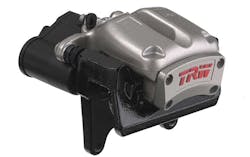Electronic parking brake tech
Every day in every way, electronics are taking over mechanical tasks. Thanks to alleged unintended acceleration, almost everyone now knows about throttle by wire. But parking brakes by wire still seems like a secret for many, even professionals.
Yet, the technology is not so new. Electronic parking brakes have been around since the mid-2000s. The 2004 Audi A8 had them. Since the 2009 model year, all Audi vehicles have electronic parking brakes. So do some Volkswagens, Volvos, Cadillacs, Buicks, Jaguars, Lexuses and more.
There are two basic designs. The first, and simplest, still uses cables to actuate the parking brakes in the traditional manner. Cables from the wheels attach to a motor that pulls and releases similar to the way a manual lever pulls and releases. But an electrical switch replaces the lever. Lexus, for example, uses this design.
Closing the circuit sends a signal to the parking brake module that, in turn, turns the reversible motor to apply the brakes. Upon close examination, you may think that the motor looks a lot like a window regulator motor, and you would be right. Of course the torque is multiplied substantially by a transmission.
The second design has no cables. Instead, the actuators are attached directly to the rear calipers. A signal to the controller relays power to the motors to clamp the brake pads against the rotors. The distance the pads have to move is minimal, but must be maintained through regular adjustment, which is done automatically. Volkswagen, for example, uses this design.
In most cases, a parking brake switch, either a pull on/push off or a push on/push off, actuates the parking brakes. In some cases, the brakes are actuated when the transmission is shifted into park. On systems with the caliper-mounted motors, the electronic parking brake can double as a hill-hold for vehicles with a manual transmission.
Of course, these command circuits have been added to the vehicle CAN bus which has been on virtually all cars sold in the U.S. since it was made mandatory with the 2008 model year.
Single motor/cable system
Let’s take a look at the 2009 Lexus LS 460 as an example of the single motor/cable system.
In the manual mode, the parking brakes are set by activating a switch while in the automatic mode; the brakes are activated when the transmission is shifted into and out of park, while pressing the brake pedal.
As long as the car is not moving, pressing the switch runs the motor to tighten the parking brake cable. The tension will be increased to a value depending on the tilt of the vehicle (hills) based on input from the yaw rate and acceleration sensor. Once it reaches the desired clamping force, the motor stops and maintains the tension.
When the switch is pulled up for release, the motor turns in the opposite direction until the slack reaches a predetermined value. All values are orchestrated by the control module.
If the switch is pressed while the car is moving, the brakes will apply for as long as the switch is held, then will release as soon as the switch is released.
If the battery dies, the parking brake system won’t operate. To release the parking brakes manually, a special tool is included along with the jack tools. Install the correct bit on the tool, remove the plug from the spare tire well, insert the tool and turn counterclockwise to release.
If power was totally lost, or the control module or motor replaced, the electronic parking brake system will have to be re-initialized. Of course, a scan tool is required. Incidentally, the parking brake operates even if the CAN system quits.
Servicing the brake pads, calipers and parking brake shoes does not require any special techniques.
[PAGEBREAK]Caliper-mounted motors
The Volkswagen Passat is an example of a car with caliper-mounted motors that actuate the caliper pistons to move the brake pads to create clamping force. The components are designed to hold the car securely, even if the onboard electric power supply fails.
Indicator lights in the instrument cluster and in the EPB button switch show whether the parking brake has been activated. An operating noise from the EPB also indicates that the brake is being applied. A large button (to the left of the headlight switch) operates the electronic parking brake. The dynamic automatic release makes manual release unnecessary. It releases the parking brakes upon driving off.
In the VW system, the control module is built into the caliper’s motor assembly rather than separately.
Care must be taken when servicing the brake pads on these vehicles. It cannot be done without a scan tool.
Retracting the calipers
Briefly, here is the technique to retract the calipers: Using the scan tool, cycle the brakes on and off to erase any stored trouble codes. Then use the proper scan tool commands to retract the calipers. If the caliper pistons do not retract, but the motor has run and tried to retract them, the pistons then need to be pushed back manually.
After replacing the brake pads, you have to set the proper pad-to-rotor clearance. After cycling the parking brake switch on and off three times, use your scan tool to set the basic pad setting. The calipers will grab and release three times.
Of course, the service details vary by make, model and year, so be sure to consult your service information prior to digging into a job. ●
Visit us online at www.autoserviceprofessional.com for additional information and photographs on this topic.
